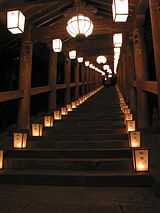Hase-dera
| Buzan Shinrakuin Hase-dera | |
|---|---|
 | |
| Information | |
| Denomination | Shingon-shu Buzan-ha |
| Founded | 8th century (727?) |
| Priest(s) | Senyo |
| Address | 731-1 Hatsuse, Sakurai, Nara Prefecture |
| Country | Japan |
| Website | http://www.hasedera.or.jp/index.html |
Hase-dera (長谷寺) is the main temple of the Buzan sect of Shingon Buddhism. The temple is located in Sakurai, Nara Prefecture, Japan. The Main Hall is a Japan's National Treasure.
Overview

According to the description on the bronze plaque of the Hokke Sessō-zu (銅板法華説相図 dōban hokke sessō zu),[1] the temple was first built in 686 and dedicated to Emperor Temmu, who was suffering from a disease. Later in the year 727, the temple was further expanded by order of Emperor Shōmu and the statue of the eleven-faced Kannon was placed near the original temple that enshrined the bronze plaque.
The temple was favored by aristocrats such as the author of the Kagerō Nikki and the author of the Sarashina Nikki during the Heian period. The temple has been burnt down as many as ten times since the 10th century. Hase-dera was consistently popular with visitors,helped by the fact it was situated on the route to Ise Shrine.[2]
Hase-dera has flourished as one of the centers of the reformed Shingon Buddhism, particularly after the arrival of priest Sen'yo from Negoro-ji in 1588.
The best times of year to visit this temple are in spring, because at this time of year the peonies that line the 200m walkway from the gate to the hall are in bloom. There is approximately 700 Chinese peonies planted here and they are a popular attraction.[3][4] Autumn is the other time of year that Hase-dera is especially beautiful, when the many maple trees have turned to a stunning red color.[4]
The current Main Hall, a reconstruction of 1650 built by donation of Tokugawa Iemitsu, represents the scenic beauty of the temple, together with the wooden staircase (登廊 noborirō) leading to the Hall from the Niō gate, and the cherry trees surrounding the complex.[2]
Treasures

The designated Important Cultural Properties at Hase-dera include:
- The Main Hall (National Treasure): The Main Hall at Hase-dera is one of the largest halls in the Nara prefecture, the statue of the Eleven Faced Kannon is located in this hall.[5]
- The bronze plaque of the Hokke Sessō-zu (National Treasure): This plaque measures 75 cm(width)x 84 cm (height) and features at its center a hexagonal three story pagoda, surrounded by a series of panels showing two Buddhas sitting on lotus seats, as well as various deities and monks. The lower panel features 27 lines of inscription that is boarded by two guardian gods.
- The Hokke Sutra (National Treasure)
- The Niōmon (Important Cultural Property): The Niō are present at the gates of many Japanese Buddhist temples, one for each side of the entrance. These statues are protectors of the temple, and can be thought of in English as two benevolent kings. These statues lend their name to the gate of the temple, which has become known as the Nio gate. The Nio have a threatening appearance in order to discourage demons and thieves.[6]
- The Shōrō (Important Cultural Property): In 1984 the original bell was replaced, and the original was placed in the treasure hall[7]
- The Staircase (Important Cultural Property): The staircase is made up of 399 small stone steps, and is around 200 meters long. Pilgrims who visit the temple believe that when walking the staircase it help to get rid of the 108 illusions that they believe lead to all human suffering.[8]
- The Eleven-faced Kannon (Important Cultural Property): The Statue of the Eleven Faced Kannon (or the Goddess of Mercy) is 9.3 meters or 31 ft tall and it is said that it was carved by a priest known as Tokodu.This is said to be the largest wooden statue in Japan. This statue depicts one of the most popular Deities in Japan, and has 11 faces. These faces are made up of one primary face and 10 secondary and are said to allow Kannon to see all around, in case anyone is in need of her assistance.[4]
-

The Main Hall
-

The Main Hall
-

The Niō gate
-

The Bell tower
See also
- List of National Treasures of Japan (crafts-others)
- List of National Treasures of Japan (temples)
- List of National Treasures of Japan (writings)
- For an explanation of terms concerning Japanese Buddhism, Japanese Buddhist art, and Japanese Buddhist temple architecture, see the Glossary of Japanese Buddhism.
Notes
- ↑ The plaque is a designated National Treasure of Japan.
- ↑ 2.0 2.1 Sanmi Sasaki; Shaun McCabe, Iwasaki Satoko and Sen Sōshitsu XV (2005). Chado the Way of Tea. Tuttle Publishing. p. 541. ISBN 0-8048-3716-3.
- ↑ http://www.jnto.go.jp/eng/location/regional/nara/hasedera.html
- ↑ 4.0 4.1 4.2 Chris Rowthorn (2007). Lonely Planet Japan. Lonely Planet; 10 edition. p. 196. ISBN 1-74104-667-X.
- ↑ http://www.pref.nara.jp/nara_e/dd_aspx_menuid-1295.htm
- ↑ http://www.onmarkproductions.com/html/nio.shtml
- ↑ http://www.djibnet.com/photo/%E9%95%B7%E8%B0%B7%E5%AF%BA/hase-dera-bell-blossoms-2469652725.html
- ↑ Linda Kay Davidson, David Martin Gitlitz (2002). Pilgrimage: from the Ganges to Graceland: an encyclopedia, volume 10. ABC-Clio; illustrated edition. p. 229. ISBN 1-57607-004-2.
References
- Ed. Nara Chamber of Commerce (2006). Nara Mahoroba Somurie Kentei Official Textbook. Yama to Keikoku sha. p. 129. ISBN 4-635-60050-5.
- Pamphlet distributed by Hase-dera on site. (Japanese)
External links
- Hasedera (Japanese)
- Photos of Hasedera Temple
- Hase Tourist Association (Japanese)
Coordinates: 34°32′09″N 135°54′25″E / 34.53583°N 135.90694°E
| Wikimedia Commons has media related to Hasedera (Sakurai). |
| |||||||||||||||||||||||||||||||||||||||||||||||||||||